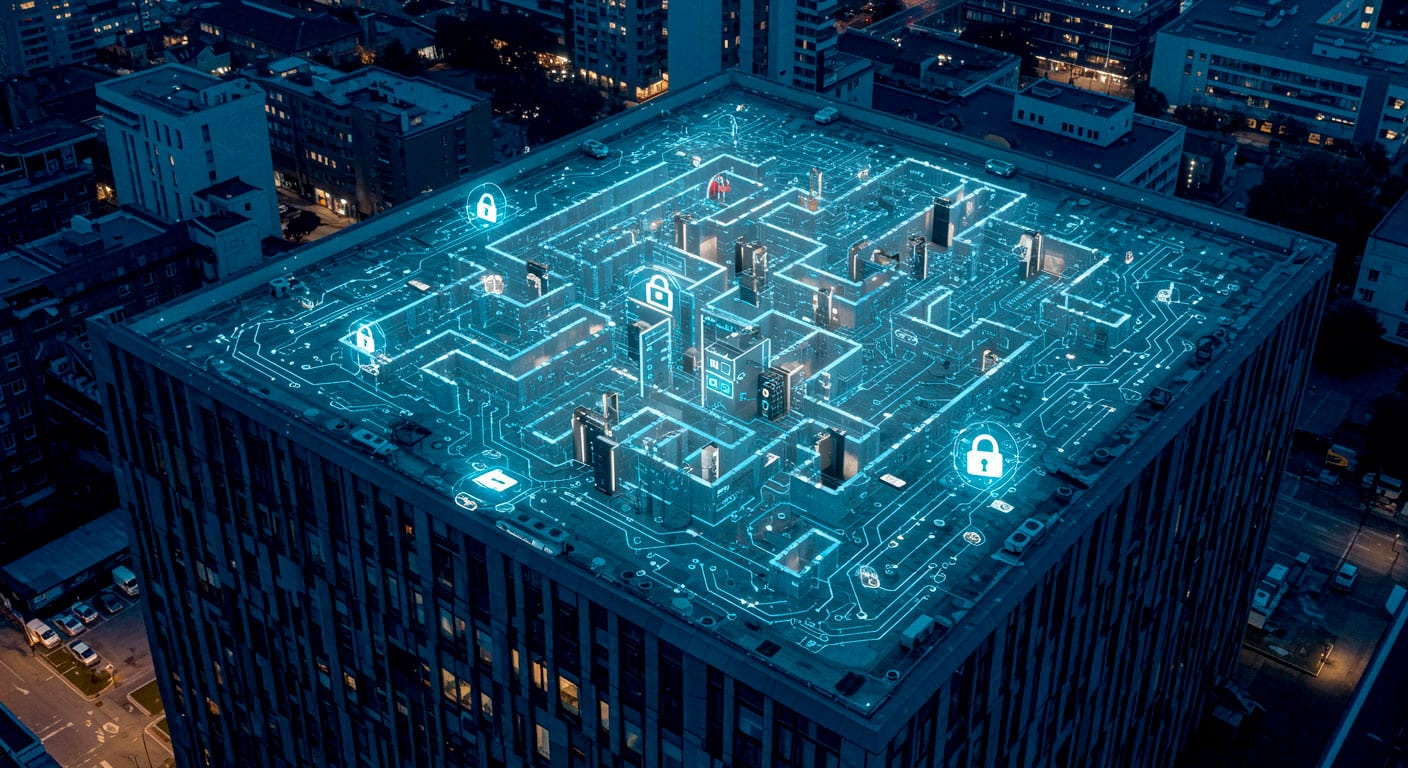Why the future of corporate protection has already begun
Many companies talk about digital transformation. But when it comes to the topic of physical security, the reality is often different: isolated systems, manual controls, paper records, little integration with IT and even less with business management.
Meanwhile, threats, costs, and responsibilities increase.
Today, digitizing physical security is not a “futuristic” project-it is a concrete lever to protect critical assets, improve operational resilience, and lower hidden costs.
In this article we will look at how to do this, what it really takes, and what results a company that decides to evolve its security digitally can achieve.
What it means to digitize physical security
Digitizing does not mean simply installing IP cameras or NFC badges. It means:
- Making security control smart and centralized, from gates to H24 garrisons
- Integrate data between physical and digital systems(video surveillance, access control, intrusion detection, building management)
- Moving from a reactive to a predictive approach using AI, analytics, and real-time monitoring
- Use dashboards and alerts to make quick, measurable decisions
In short: move from “managing security” to directing security as an integral part of business.
What problems does it actually solve
- Operational complexity and data dispersion
Every site, every plant, every shift has different rules, systems, and responsibilities.
Digitizing means bringing everything together in a single, accessible, traceable, governable platform. -
Intervention timing and coordination
In the event of an alarm, seconds count. A digital system makes it possible to verify the event, alert personnel, and activate countermeasures automatically.
Less time wasted, less ambiguity. - Hidden costs and inefficiencies
Oversized garrisons, redundant shifts, inadequate training: with the right data, resources and investments can be optimized without compromising safety. - Compliance and audit
Every access, every alert, every event is recorded.
Immediate reports for tenders, audits, auditors, government agencies and stakeholders.
Key technologies for the digital transformation of security
Digitizing enterprise physical security doesn’t just mean adopting a few IP cameras or electronic badges. It means creating an integrated ecosystem capable of collecting data, reading it in real time and triggering rapid, measurable, scalable responses.
Here are the main technologies driving this transformation:
-
PSIM (Physical Security Information Management) Platforms.
PSIMs are intelligent systems that aggregate and centralize all information from physical security devices: cameras, access, sensors, alarms, perimeter control.
They enable:
- View real-time events from multiple sites
- Correlate data between different sources (e.g., access + alarm + video)
- Automate response procedures
- Produce comprehensive reports and audits in just a few clicks
Result: strategic control of security from a single directorate, including on a national or international scale.
-
Smart video surveillance with AI and video analytics
Next-generation cameras don’t just record: they detect, analyze, and report suspicious behavior.Most common features:
- facial recognition (where permitted by regulation)
- automatic movement tracking
- detection of abandoned or removed objects
- Behavior analysis (gatherings, abnormal access, unusual routes)
- thermal or environmental monitoring
Result: fewer false alarms, more accuracy, greater predictive ability.
-
Advanced digital access control
Forget anonymous keys or badges: today we work with digital identities, biometric recognition, virtual badges on smartphones, geofencing and dynamic permissions.It is possible:
- Restrict access based on role, location, and time of day
- Track all movements automatically
- Revoke or modify permits in real time
- Integrate with HR, management and shift software
The result: more security, less complexity and full control over every gateway.
-
IoT, sensors and edge computing
Connected sensors monitor all kinds of physical variables: motion, vibration, door opening, temperature, humidity, gas, smoke, etc.
The system reacts in real timewithoutthe need for human intervention, thanks to edge computing (data processing directly on the device).Practical applications:
- Protection of electrical panels, technical cabinets, storage rooms
- H24 monitoring of unauthorized access or tampering attempts
- Integration with building automation for evacuations, automatic shutdowns or controlled blackouts
-
Drones and robots for autonomous surveillance
In large environments (power plants, energy plants, logistics depots) drones and robots can:
- Automatically patrol areas, even at night or in extreme conditions
- Send real-time images to a control room
- Detect thermal, acoustic or visual abnormalities
- Reduce the need for permanent staff in remote areas
Result: more coverage with fewer resources and greater timeliness.
-
Digital twin and virtual simulations
A digital twin is a virtual replica of a real site (plant, warehouse, building).It allows you to:
- Simulate risk scenarios (e.g., intrusion, fire, evacuation)
- test emergency procedures and plans
- Optimize the arrangement of devices and personnel
- Anticipate critical issues before they occur
Result: more strategic and customized security design and management.
How to get started: the 5 priorities for every company
Digitizing physical security is a process that must be driven methodically. It’s not enough to just buy new technologies: you need a clear, sustainable path that is aligned with business objectives.
Here are the 5 concrete priorities for setting up an effective project, avoiding budget dispersion or disconnected solutions.
- Mapping existing systems and critical operational issues
Every company starts from a different situation. Before introducing anything new, it is essential to know what is already there and how it really works.
Activities to be performed:
- Mapping of current systems (video surveillance, access, alarms, principals)
- Audit of actual coverage (blind areas, non-functioning devices, unnecessary duplication)
- Process analysis: what is manual? What is automated? Where is time or resources wasted?
This stage allows an objective starting point to be defined, on which to base any subsequent decision.
- Define specific needs by site, function, and risk
There is no one-size-fits-all solution for all companies or all sites. A headquarter in the city center has very different needs from a plant in an industrial area.
Questions to ask:
- What are the critical assets?
- What are the most likely threats (theft, sabotage, illicit access, espionage)?
- Which departments/processes should be protected as a priority?
Digitizing does not mean standardizing everything. It means personalizing the intelligence of the system.
- Involve all key stakeholders
Too often, security digitization projects are carried out only by the technical or security department.
Error.
To really work, you need the involvement of:
- IT(for data integration and governance)
- Operations / Production(not to interfere with processes)
- Legal / Compliance(for regulatory, privacy and audits)
- Top management(for strategic vision and budget commitment)
Digital physical security is a cross-cutting issue: either it is shared, or it fails.
- Starting with a high-impact pilot project
There is no need for large initial investment. It is much more effective to select 1 or 2 key sites or processes, where to test:
- Integration between devices and systems
- The reduction of intervention time
- The improvement of operational efficiency
- The feedback from users
The goal is to demonstrate in a short time that the project works, generates ROI and can be scaled up.
- Build a medium-term roadmap with clear KPIs
Security digitization is not an event. It is a process.
Therefore, a 3-step roadmap is needed:
- Phase 1: analysis and pilot
- Phase 2: extension and consolidation
- Step 3: Integration into strategic processes (ESG, audit, compliance, HR, sustainability)
For each phase, it is critical to define measurable KPIs: reduction in false alarms, average response time, cost reduction, increased coverage, etc.
The benefits that matter to CEOs and CDAs
- Faster, data-driven decisions
- Greater transparency and control for governance
- Operational savings of up to 20-30% in 2 years
- Increased compliance and attractiveness to customers and investors
- Reduction of reputational and legal risk
Conclusion
Physical security is no longer a matter of “guarding an entrance.”
It is a strategic function that can be managed as an industrial process, driven by data and digital tools, with direct impacts on the company’s value, reputation, and operations.
Those who start today are competitive.
Those who wait will chase.



